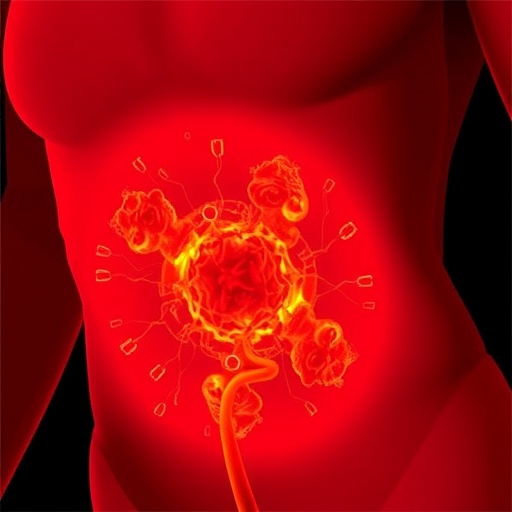In a groundbreaking study published in Nature Metabolism, researchers have unveiled a surprising and intricate link between fat cells and the regulation of body temperature following food intake. The team led by Felix, Saha, and de Groot has identified the metabolite N-acetylaspartate (NAA), produced by adipocytes, as a pivotal mediator in the control of postprandial thermogenesis. This discovery challenges long-held perceptions of fat purely as an energy reservoir, instead highlighting its dynamic role as an endocrine organ influencing systemic metabolic homeostasis.
N-acetylaspartate has traditionally been studied in the context of the nervous system, where it is abundant and has been implicated in neuronal health and function. However, this novel research shifts the perspective by exploring its unexpected synthesis and release from white adipose tissue in response to feeding. The investigators employed a combination of sophisticated metabolomic profiling and in vivo imaging techniques to track fluctuations in NAA levels and their physiological consequences. Their work suggests that fat-derived NAA acts as a signaling molecule that adjusts body temperature after meals, optimizing energy expenditure and potentially contributing to metabolic flexibility.
To decode the underlying mechanisms, the researchers utilized genetically engineered mouse models lacking the key enzyme responsible for NAA synthesis specifically in adipocytes. These conditional knockout mice exhibited blunted elevations in body temperature following food intake, a phenomenon known as diet-induced thermogenesis. Alongside decreased thermogenic response, these animals demonstrated shifts in systemic energy balance, supporting the notion that adipocyte-produced NAA is indispensable for the appropriate thermoregulatory adaptation to feeding.
.adsslot_e2UfkETczX{ width:728px !important; height:90px !important; }
@media (max-width:1199px) { .adsslot_e2UfkETczX{ width:468px !important; height:60px !important; } }
@media (max-width:767px) { .adsslot_e2UfkETczX{ width:320px !important; height:50px !important; } }
ADVERTISEMENT
Probing deeper into molecular pathways, the team identified that NAA influences thermogenesis by modulating mitochondrial activity in brown and beige adipocytes. Specifically, NAA appears to enhance mitochondrial uncoupling processes, thereby increasing heat production without generating adenosine triphosphate (ATP). This adaptation facilitates the burning of calories through heat, a process vital for maintaining energy homeostasis and preventing excess weight gain under nutrient-rich conditions. These findings suggest that NAA serves as a key biochemical relay between white fat depots and thermogenic adipose tissues.
Moreover, the researchers extended their analysis to human adipose tissue samples, revealing similar expression patterns of the NAA-synthesizing enzyme and correlating postprandial increases in circulating NAA. This translational aspect strengthens the biological relevance of the findings and opens avenues for therapeutic strategies targeting NAA pathways to combat obesity and metabolic disorders. The work fills an important gap in understanding how adipose tissue crosstalk orchestrates whole-body metabolism dynamically in response to feeding.
The implications of this study are profound in the context of metabolic diseases, particularly given the rising global prevalence of obesity and type 2 diabetes. By delineating a previously unrecognized biochemical axis involving NAA from fat cells, the findings pave the way for innovative interventions aimed at modulating thermogenesis and energy expenditure. Future research could explore pharmacological modulation of NAA pathways to enhance diet-induced thermogenesis, offering a promising route to prevent or treat metabolic syndrome.
Notably, the study challenges the classical dichotomy of white versus brown adipose tissue by revealing that white fat not only serves as an energy reservoir but also actively governs systemic thermoregulatory processes through metabolite signaling. This integrated view of adipose tissue function underscores the complexity of energy homeostasis and the importance of inter-organ communication in metabolic health.
The methodology of the study stands out for its multi-modal approach, combining metabolomic profiling, genetic mouse models, in vivo thermographic imaging, and human tissue validation. This comprehensive strategy lends robustness to the conclusions and allows for a detailed mechanistic understanding of how NAA modulates postprandial body temperature. Advanced imaging techniques enabled real-time measurement of thermogenic responses, while targeted gene deletion pinpointed the specific source of metabolite production within adipocytes.
Intriguingly, the study also found that NAA levels rise rapidly following nutrient absorption, suggesting a tight temporal correlation between feeding and thermogenic activation. This dynamic response indicates that adipocyte-derived NAA may function as an immediate postprandial signal orchestrating metabolic adjustments. Such temporal specificity is critical for fine-tuning energy expenditure to match nutrient availability, thus preventing maladaptive weight gain.
In the broader metabolic context, these insights into NAA’s role complement existing knowledge about hormonal regulators of thermogenesis, such as leptin and adiponectin. While hormones exert systemic effects, metabolites like NAA might provide localized and rapid modulation of energy balance. This layered regulatory network highlights the evolution of adipose tissue as a multifaceted organ capable of integrating nutritional cues and coordinating physiological responses.
The discovery also has implications for understanding febrile responses and febrile thermoregulation, as the mechanisms controlling temperature elevation during feeding could intersect with inflammatory or stress-induced thermogenic pathways. Elucidating such links may uncover novel connections between metabolism, immunity, and thermoregulation.
Another exciting aspect of the research is its potential relevance to aging and metabolic decline. Since adipose tissue function deteriorates with age, altering NAA production or signaling could impact age-related changes in thermoregulation and energy homeostasis. Targeting NAA synthesis in adipocytes might thus offer avenues to mitigate metabolic dysfunction in elderly populations.
Furthermore, the authors noted that diet composition influenced the magnitude of NAA-mediated thermogenesis, with high-fat meals eliciting a more pronounced response. This suggests a nuanced interplay between nutrient quality and adipocyte metabolite production, offering insights into how dietary factors shape metabolic health.
The study also revealed that adipocyte NAA production is closely linked with mitochondrial biogenesis and function, reinforcing the central role of adipocyte mitochondria as metabolic hubs. Enhancing mitochondrial capacity through NAA-related pathways could therefore represent a strategy for boosting metabolic rate and combating energy excess.
Finally, the authors speculate on the evolutionary advantages conferred by metabolite-mediated thermogenesis. By enabling rapid and efficient adaptation to food intake, NAA signaling might have supported survival in fluctuating environments, balancing energy storage and expenditure.
In conclusion, the identification of N-acetylaspartate as a key fat cell-derived regulator of postprandial body temperature reshapes our understanding of adipose tissue’s role in energy homeostasis. This landmark study opens up exciting research directions targeting metabolic diseases through novel biochemical pathways and underscores the intricate biology underpinning human metabolism.
Subject of Research: Regulation of postprandial body temperature by adipocyte-derived N-acetylaspartate and its role in systemic energy homeostasis.
Article Title: N-acetylaspartate from fat cells regulates postprandial body temperature.
Article References:
Felix, J.B., Saha, P.K., de Groot, E.L. et al. N-acetylaspartate from fat cells regulates postprandial body temperature. Nat Metab (2025). https://doi.org/10.1038/s42255-025-01334-6
Image Credits: AI Generated
Tags: adipocyte endocrine functionenergy expenditure after mealsfat cell metabolismfeeding response and thermoregulationgroundbreaking research on fat cellsmetabolic homeostasis and flexibilitymetabolomic profiling techniquesmouse models in metabolic researchN-acetylaspartate role in thermogenesisnervous system metabolites in adipocytespostprandial body temperature regulationwhite adipose tissue signaling





